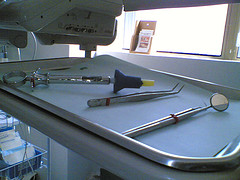 Going to the dentist is a much hated proposition for many people but if you have an anxiety disorder this can be an extraordinary ordeal of cosmic proportions.
Going to the dentist is a much hated proposition for many people but if you have an anxiety disorder this can be an extraordinary ordeal of cosmic proportions.
O.K. that was clearly an exaggeration however it can really be difficult to go and see a dentist if you have a “nervous problem”.
In my last post (Dental Debacle ) I wrote about my hellish visit to the dentist. It was all related to an “overdose” or more accurately a misplacement of local anesthetic that contained adrenaline without me knowing it.
And although I did include a no adrenaline warning on my last post I wanted to provide some clear information on why this is important for those of us that have anxiety disorders.
For starters Novocaine is rarely used in modern dentistry. This is mainly because it takes too long to take effect and causes allergic reactions in some people. Nowadays dentist most commonly use lidocaine (a.k.a xylocaine).
For procedures that take a while to complete a dentist may employ marcaine which is a long-lasting anesthetic. These drugs are used as a local anesthetic and will not effect the rest of your body or mind in any dangerous way.
The only problem however is if the dentist uses these drugs with epinephrine (adrenaline) added to the mix. This is because adrenaline may trigger palpitations, muscle twitching, sweating and a general sense of panic.
In case you’re wondering adrenaline is added (the drugs come with or without) because it provides the dentist with some significant advantages and it’s not that he/she is secretly trying to freak you out.
It turns out that when you add adrenaline to the mix it helps to constrict the blood vessels in the area of the injection. This helps to stop or at least minimize bleeding while work is being done. The second benefit is that it prolongs the effects of the drug – in this case the numbing effect so that you can be injected less.
There are also other drugs, such as carbocaine , that can be used as the anesthetic. But what is important is not the type of “caine” used it is that you tell your dentist “no adrenaline please”. This can make your day, and your dentist’s day, more pleasant. If you don’t mind getting poked a few more times than this is the way to go. Simply tell your dentist that you want the local anesthetic that does not contain adrenaline.
If you prefer to get it all done with fewer shots than consider some of these tips.
1. Talk to your dentist and be clear about your anxiety. You don’t have to go into detail and hand over all your medical records pertaining to your anxiety, but just make it clear that you are very uneasy with getting dental work done. This will hopefully tell the dentist that he/she should be gentle and that they should expect potentially sudden signs of panic on your end. Communication is key for you both because it can go a long way in informing the dental staff on how to treat you.
2. If you decide to allow the adrenaline for the sake of less bleeding, more numbness and fewer injections than you have to know that if you do have an adverse reaction (like me) it is not dangerous. If you know that you’re in good health and have no heart conditions than the bottom line is that you might experience a nasty adrenaline rush, but no more.
3. You can also consider taking anxiety medication for the visit. Taking a small dose of an anti-anxiety drug might be a good alternative. Although I don’t support the use of drugs over any long-term period, using it in this instance would not be the worst thing in the world.
4. You can also have the doctor try laughing gas to take off the edge.
5. You can also listen to some soothing music over head phones to help you relax.
Whatever method(s) you decide to employ the last thing you want to do is avoid the dentist all together. This can actually cause serious health problems down the line. If you neglect your pearly whites it can lead to gum disease and tooth loss which may contribute to heart disease. Don’t let your fears get in the way of you protecting your long-term health.
Listen, I hate the dentist as much as the next guy, but I also understand the importance of visiting the white washed torture chamber from time to time. It’s o.k. to be afraid but just don’t let it stop you from doing what you have to do. Despite my ordeal I’m still here crunching away on my keyboard so you’ll be fine as well. As a matter of fact I’m due for a follow-up in two weeks and I plan to be there gritted teeth and all.





Thanks for this. My brother went to the dentist a few months ago and it really sent him off into a tailspin of despair. He denies that he has an anxiety disorder so that is part of the problem.
I too have severe anxiety and had avoided the dentist for years. Then, when it became too much I made an appointment. When the work was beginning they gave me a shot for numbing. I then began to tremble and my heart felt like it was going to jump out of my chest. This made me very upset. When I told them what was happening they stated that it was the adrenaline. They made it seem like I was making a big deal about it. Thanks for the info. I will ask for no adrenaline in the future.
I went to the dentist today, and as I have been feeling particularly anxious this last week, I was surprised that whilst in the chair I felt incredibly relaxed, despite various instruments in my mouth, not wanting to swallow the awful tasting chemicals and so on. I asked about the anasthetic and if it had a sedative in it and he said “no, it does have adrenalin in it though” and explained it was to keep the drug in the vessels at site of injection for longer. Anyway, I would have thought adrenalin would have made me feel as you describe above, but it was quite the opposite in fact!
I never knew about the adrenaline until a few weeks ago. I’ve had a lot of work done, so getting anaesthesia and drilling are common place for me. Recently I had noticed that after they give me the shots I feel so immediately numb and start to panic that I’m going to throw up. I always thought it was just me and my anxiety, maybe anxiety from the shots hurting (feels like they’re shoving that needle into your brain!) This last time, I made a joke about “now that I’m done shaking” to the dentist and he told me about the adrenaline and how it just does that to some people. Anyone with anxiety plus hypochondria knows how we struggle with “psychosomatic” symptoms and people telling us it’s all in our head. So I asked yesterday to get the anaesthesia without adrenaline which they gladly did. It took forever to kick in and even then I could still feel some. I was only getting a crown placed so no drilling. I think if/when I need more drilling I’m going to get the adrenaline one and try to deal. I prefer to feel NOTHING, and that one seems to work better. I’ll just have to drug myself beforehand haha. I don’t think most dr’s even look at those sheets they make us all fill out, because mine clearly says I have an anxiety disorder.
Plain solutions such as Mepivacaine 3% (Carbocaine 3% plain) and Prilocaine 4% (Citanest 4% plain) work well in some, but not all situations.
For a lower block, either of the plain solutions will work as well as the usual 2% Lidocaine 1:100,000 epinephrine – just with a shorter duration. Your dentist isn’t likely to use 4% Prilocaine for a lower block because it has a higher risk of causing a patient to become permanently numb, so they will almost certainly choose Mepivacaine 3% there.
On the upper, either can, in theory, be used, but neither last long. A dentist is more likely to choose the Prilocaine up there because it’s a 4% solution, but the effects might still not be as profound. Having had simple extractions done with Mepivacaine 3% on the upper, I will say it was perfectly painless in my case. Just remember to ask whether you need to take any Advil beforehand – you’ll want this working beforehand since the local will wear off very quickly.
For the upper teeth, there are also versions of Prilocaine and Articaine that have half the amount of epinephrine normally used. These might be considered where the plain solutions don’t work. They might still have some effects, but not as bad. 4% Prilocaine with 1:200,000 epinephrine did raise my blood pressure, but it definitely wasn’t as bad as what happened with Lidocaine 1:100,000.
If you have a deep filling on the upper, the use of one of these 1:200,000 solutions is probably a good idea – especially the Articaine. The amount given for a shot on the upper is a lot less than the lower. For a lower it makes no difference which one they use.
There are actually only 2 “caines” that routinely come without a vasoconstrictor – Carbocaine 3% plain (Mepivacaine) and Citanest 4% plain (Prilocaine).
You won’t find Lidocaine without epi in a dentist’s office, and you won’t find Bupivacaine without it in a dentist’s office either. Articaine also comes without epi but this formula is rarely found outside Germany.
Of these, Prilocaine is more likely to be used on the upper because it’s a 4% solution and thus more effective for this. Neither last long on the upper.
Of these, for a lower block you’ll more likely be seeing Carbocaine 3% plain be used because 4% solutions are more likely to cause permanent numbness. Studies have also shown that 3% Carbocaine plain and 4% Prilocaine plain are equally as effective as Lidocaine 1:100,000 epi for lower blocks.
I don’t think you would want to have surgical extractions done without epi on the upper – but for something that’s going to be easy it is entirely possible.
Also watch out for the green striped cartridges. These are really nasty 1:50,000 epinephrine.